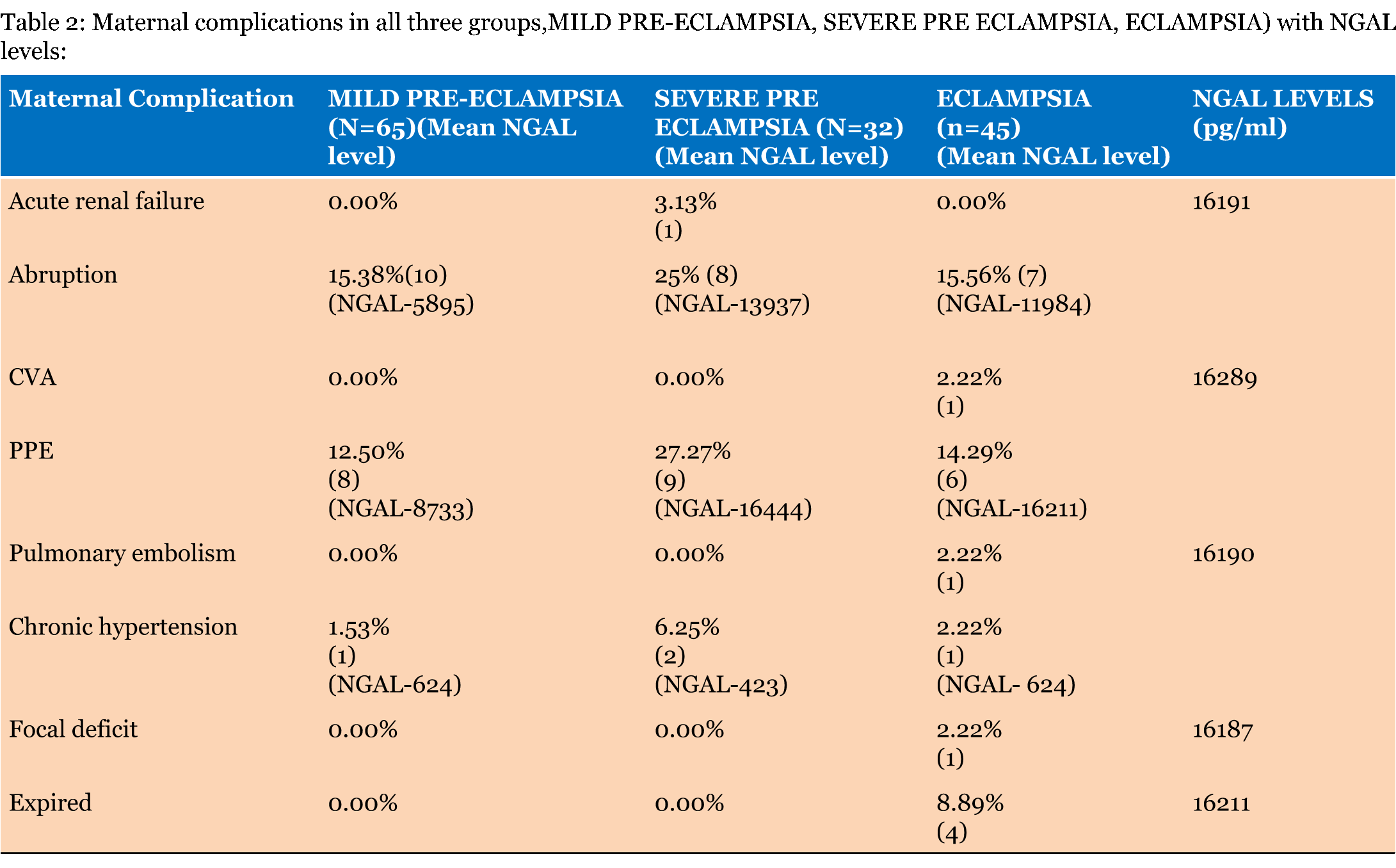| Table of Contents |  |
|
Original Article
| ||||||
| Fetomaternal outcome in preeclampsia and eclampsia and its association with neutrophil gelatinase-associated lipocalin in North Indian population | ||||||
| Munna Lal Patel1, *Neha Negi2, Pushplata Sachan3, Rekha Sachan4, Radheyshyam5 | ||||||
|
1MD, Associate Professor, Department of Medicine, King George Medical University, U.P. Lucknow.
2MD, Senior Resident, Department of Obstetrics &Gynaecology, King George Medical University, U.P., Lucknow. 3MD, Assistant Professor, Department of Physiology, Career Institute of medical Sciences, Lucknow. 2MS, FICOG, Professor, Department of Obstetrics & Gynaecology, King George Medical University, U. P. Lucknow. 3MD, Assistant Professor, Department of Geriatric Mental Health, King Georges' Medical University, Lucknow. | ||||||
| ||||||
|
[HTML Abstract]
[PDF Full Text]
[Print This Article]
[Similar article in Pumed] [Similar article in Google Scholar] |
| How to cite this article |
| Patel ML, Negi N, Sachan P, Sachan R, Radheyshyam. Fetomaternal outcome in preeclampsia and eclampsia and its association with neutrophil gelatinase-associated lipocalin in North Indian population. Edorium J Matern Child Health 2016;1:1–7. |
|
Abstract
|
|
Aims:
Hypertensive disorders of pregnancy (HDP) seriously endangers the safety of mother and fetus during pregnancy. The aim of this study was to evaluate the association of neutrophil gelatinase-associated lipocalin levels (NGAL) with feto-maternal outcome in hypertensive disorders of pregnancy.
Methods: Prospective case-control study was carried out for one year. After informed consent, ethical clearance, total 180 pregnant women at 28–40 weeks of gestation age were recruited, out of which seven were lost to follow-up. Out of the remaining 173 patients, 31 were taken as controls, 65 as mild preeclampsia, 32 as severe preeclampsia and 45 as eclampsia. Estimation of serum neutrophil gelatinase- associated lipocalin was done by the enzyme linked immunosorbent assay (ELISA) technique, by using sandwich ELISA kit. Results: Negative correlation was observed between NGAL value with baby weight, maternal complication and neonatal death. Babies with low (2–2.5 kg) and very low (<2.0 kg) birth weight had significantly high NGAL levels compared to adequate for gestational age (term) babies (>2.5 kg), p-value < 0.001. The odds of resuscitation required were 2.69 times in birth weight group of 2.0–2.5 kg and with birth weight > 2.5 kg odds of resuscitations were 1.43 times. The odds of 5.84 times higher with admission to NICU in birth weight group of 2.0–2.5 kg as compared to birth weight > 2.5 kg (1.65 times). Conclusion: NGAL may also be an indicator for adverse maternal and neonatal outcomes. | |
|
Keywords:
Fetal outcome, Hypertensive disorders of pregnancy, Maternal outcome, Neutrophil gelatinase-associated lipocalin (NGAL)
| |
|
Introduction
| ||||||
|
One of the leading causes of increased maternal morbidity and perinatal mortality is hypertensive disorders of pregnancy (HDP). About 31% of maternal deaths are attributed to hypertensive disorders of pregnancy, out of which 24.7% are due to eclampsia [1]. Hence, there is need of a sensitive prognostic marker for early detection and prediction of severity of disease, so that we could improve the maternal and fetal outcome. Neutrophil gelatinase-associated lipocalin (NGAL) has emerged as a novel marker for early detection and prediction of severity of preeclampsia in pregnant women. Kidneys plays a pivotal role in the pathogenesis of preeclampsia, NGAL is produced at the maternal-fetal interface [2], but its systemic role in preeclampsia has been studied in very few studies. Past studies reported that serum NGAL concentration was significantly increased in women who later on develop preeclampsia [3][4], few studies showed that NGAL could be used in the prediction of preeclampsia before the clinical diagnosis of disease. High NGAL levels were observed in women with severe early-onset preeclampsia and they were also at higher risk for the development of maternal complications [5] . The present study was carried out to evaluate the association of NGAL levels with feto-maternal outcome in hypertensive disorders of pregnancy. | ||||||
|
Materials and Methods
| ||||||
|
This study was a prospective case control study and was carried out over a period of one year in 2013–2014, in the Department of Obstetrics and Gynecology, Queen Mary's Hospital, King George's Medical University, Lucknow in collaboration with the Department of Internal Medicine. Study Population Sample Collection NGAL Immunoassay Maternal outcome Fetal outcome Statistical Analysis | ||||||
|
Results | ||||||
|
The total number of cases included in the study was 180, out of which seven were lost to follow-up. Out of the remaining 173 patients, 31 patients were normal controls, 65 mild preeclampsia, 32 severe preeclampsia and 45 eclampsia. In the present study, NGAL values were strongly associated with severity of disease. Mean NGAL value in control was 294.61±356.2 which was significantly less than the NGAL values in mild preeclampsia (3077.34±3227.4), severe preeclampsia (9816.75±4814.6) and eclampsia group(11372.80±2999.4) with p-value <0.00001. Above observation suggested that NGAL levels increased with the severity of disease (Table 1). Maternal complications were strongly related with increased NGAL levels, one (3.13%) patient in the severe preeclampsia group suffered from acute renal failure, she had very high NGAL (16191) levels. Total 25 women of HDP developed abruption placentae as complication and serum NGAL levels of all these women were quite high in comparison to those women who did not suffer with this complication in all three groups irrespective of the type of HDP or disease severity. Out of these 10(15.38%) patients in mild preeclampsia group had mean NGAL levels of 5895, 8 (25%) patients in the severe preeclampsia group with mean NGAL levels of 13937 and 7(15.56%) patients in the eclampsia group with mean NGAL levels of 11984 were associated with complication of abruptio placentae. Mean NGAL levels of patients with abruption were markedly high in severe preeclampsia and in the eclampsia group compared to the mild preeclampsia. Only one patient with cerebrovascular accident, one with pulmonary embolism and one patient with focal deficit was found and all these devastating complications were present in the eclampsia group and serum of all these women had significantly high NGAL level, almost more than five-fold increased from healthy controls. Total 23 women in HDP group developed post-partum eclampsia and all these women had high serum NGAL levels, 8(12.50%) patients in mild preeclampsia group with mean NGAL values of 8733, 9(27.27%) patients in severe pre eclampsia group with mean NGAL levels of 16444 and 6(14.29%) patients in the eclampsia group with mean NGAL levels of 16211 which was almost three to five-fold higher than healthy controls. Total four patients (8.89%) expired during the study and all of them were from the eclampsia group. The mean NGAL level of expired patient was 16211 and this was five-fold higher than healthy controls. A significant finding was observed that there was no significant elevation in NGAL levels of patients with mild preeclampsia (mean 624), severe preeclampsia (mean 423) and eclampsia (mean 624) super imposed on chronic hypertension as compared to those women who had mild preeclampsia (3077.34), severe preeclampsia (9816.75) and eclampsia (11372.80) (Table 2). Fetal Outcome | ||||||
| ||||||
| ||||||
| ||||||
| ||||||
|
| ||||||
| ||||||
|
Discussion
| ||||||
|
Hypertensive disorders of pregnancy are leading cause of maternal mortality worldwide. In spite of improvement in emergency services incidence is continuously rising and we still are unable to determine which patient will develop preeclampsia. This is the first study which evaluated the association of S. NGAL levels with feto maternal outcome in women suffering from hypertensive disorders of pregnancy as compared to healthy normotensive pregnant women. One author evaluated second trimester NGAL levels as a potential prediagnostic marker of preeclampsia and found that serum NGAL might be involved in the pathophysiology of preeclampsia and could be used as a marker for preeclampsia [3]. Another study showed that in the third trimester of uncomplicated pregnancies S. NGAL levels are elevated [7]. In our study, we found that the serum NGAL levels significantly correlated with the severity of disease and raised blood pressure. In our previous study, increase in SBP and DBP was positively correlated with severity of disease and with the levels of serum NGAL, positive correlation was found [8]. Recent studies showed that urinary NGAL can be an early marker of renal damage and there is also a direct and high correlation between S. NGAL and proteinuria in the preeclampsia patients [3] [9]. In our study, we also found that one patient who suffered from acute renal failure had very high NGAL values with almost four-to five-fold increase as compared to controls. In a previous study, the mean serum NGAL levels were significantly raised to almost two-to five-fold with increasing grades of acute kidney injury [10]. Another Indian study also reported pregnancy related acute kidney injury in preeclampsia [11]. This high incidence of AKI in the HDP group may be due to late referral of cases when renal damage has already occurred. Previous studies reported that the leukocyte - derived inflammatory activity and endothelial activation may lead to increase in the circulating NGAL levels [12] and both these pathways are involved in the pathophysiology of development of preeclampsia. Hence, it could be proposed that higher the NGAL values the more severe the disease and more the complications resulting in a poor feto-maternal outcome. One study reported that women with severe early-onset preeclampsia are at higher risk of maternal complications like eclampsia, HELLP syndrome, acute renal failure, subcapsular hepatic hematoma, pulmonary edema and disseminated intravascular coagulation defect and it was also observed that maternal complications were more common in women who had elevated levels of NGAL up to >100 ng/ml NGAL with (p = 0.008), an OR of 4.1 [5]. Similarly, in our study we had observed that all the maternal complications like cerebrovascular accidents, pulmonary embolism, focal deficit, acute renal failure, post-partum eclampsia were seen in patients who had significantly high NGAL values almost five-fold increased as compared to controls. Another study also concluded that compared to patients with normal blood pressure plasma NGAL concentrations were significantly elevated in women with preeclampsia and these raised NGAL concentrations were also associated with the severity of the disease [13] in accordance to our study. A significant finding observed was that there was no significant elevation in NGAL levels of patients with mild preeclampsia, severe preeclampsia and eclampsia super-imposed on chronic hypertension in our study. A recent study evaluated the relationship of neutrophil gelatinase-associated lipocalin (NGAL) levels with the severity of preeclampsia and found that higher NGAL levels were associated with severity of disease and adverse neonatal outcomes like poor APGAR scores and low fetal birth weight [14]. Similarly in our study, poor neonatal outcome like increase in the number of stillbirths, low birth weight baby, increased requirement of resuscitation and admission to neonatal unit was observed in those cases who mothers had high NGAL values irrespective of disease severity. Negative correlation was found between NGAL, APGAR scores and fetal birth weight in our study. In the present study significant difference (p-value < 0.001) was seen in NGAL values with different birth weight groups among the study subjects. This indicate that serum NGAL level provide prognostic information besides clinical presentation and incorporation of this marker, may allow identification of patients at risk for adverse outcome, necessitating timely transfer to tertiary care centre for administration of steroids and delivery. | ||||||
|
Conclusion
| ||||||
|
In the present study increased NGAL levels are associated with adverse feto maternal outcome and also with severity of disease. Hence, NGAL can be used as a prognostic marker in hypertensive disorders of pregnancy. Result of this study also indicates that the generalized endothelial damage and persistent inflammatory status in preeclampsia are responsible for adverse maternal and neonatal outcome. | ||||||
|
Acknowledgements
| ||||||
|
We are thankful to Prof. SM Natu for his helped in serum NGAL estimation. | ||||||
|
References
| ||||||
| ||||||
|
[HTML Abstract]
[PDF Full Text]
|
|
Author Contributions:
Munna Lal Patel – Substantial contributions to conception and design, Acquisition of data, Analysis and interpretation of data, Drafting the article, Revising it critically for important intellectual content, Final approval of the version to be published Neha Negi – Analysis and interpretation of data, Revising it critically for important intellectual content, Final approval of the version to be published Pushplata Sachan – Analysis and interpretation of data, Revising it critically for important intellectual content, Final approval of the version to be published Rekha Sachan – Analysis and interpretation of data, Revising it critically for important intellectual content, Final approval of the version to be published Radheyshyam – Analysis and interpretation of data, Revising it critically for important intellectual content, Final approval of the version to be published |
|
Guarantor of submission
The corresponding author is the guarantor of submission. |
|
Source of support
None |
|
Conflict of interest
Authors declare no conflict of interest. |
|
Copyright
© 2016 Munna Lal Patel et al. This article is distributed under the terms of Creative Commons Attribution License which permits unrestricted use, distribution and reproduction in any medium provided the original author(s) and original publisher are properly credited. Please see the copyright policy on the journal website for more information. |
|
|









